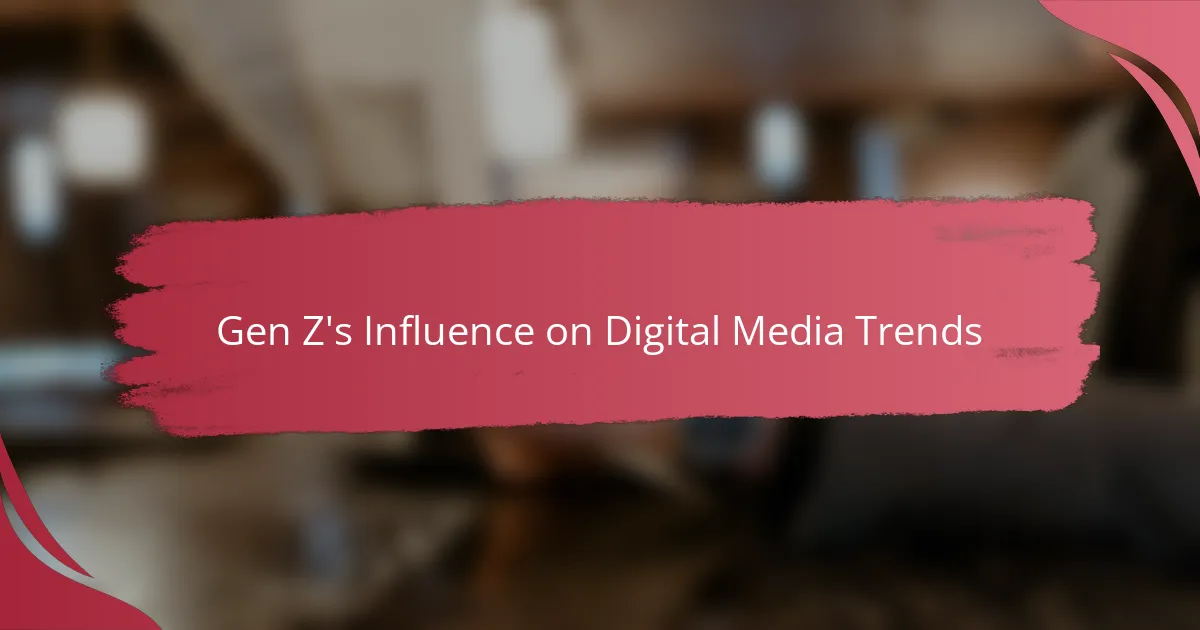Gen Z is reshaping digital media trends with their distinct consumption habits, favoring engaging and authentic content. Their preference for short-form, visually-driven platforms like TikTok and Instagram is prompting brands to adapt their marketing strategies to resonate with this influential generation.

How Is Gen Z Shaping Digital Media Trends?
Gen Z is significantly influencing digital media trends through their unique consumption habits and preferences. Their inclination towards engaging, authentic, and concise content is reshaping how brands and creators approach digital marketing.
Preference for Short-Form Content
Gen Z favors short-form content, often consuming videos and posts that last only a few seconds to a couple of minutes. Platforms like TikTok and Instagram Reels exemplify this trend, where quick, engaging snippets capture attention effectively.
To cater to this preference, brands should focus on creating concise, visually appealing content that communicates messages quickly. Aim for content that can be consumed in under a minute to maximize engagement.
Rise of Influencer Marketing
Influencer marketing has surged among Gen Z, who trust peer recommendations over traditional advertising. Collaborating with relatable influencers can enhance brand credibility and reach this demographic more effectively.
Brands should identify micro-influencers who resonate with their target audience, as these influencers often have higher engagement rates. Establishing authentic partnerships can lead to more genuine interactions and conversions.
Emphasis on Authenticity
Authenticity is crucial for Gen Z, who prefer brands that showcase transparency and realness. They are more likely to engage with content that reflects genuine experiences rather than polished, overly produced advertisements.
To connect with this audience, brands should share behind-the-scenes content, user-generated stories, and honest messaging. Highlighting real customer experiences can foster trust and loyalty.
Use of Interactive Content
Gen Z enjoys interactive content that allows them to engage actively rather than passively consuming information. Quizzes, polls, and augmented reality experiences are popular formats that enhance user participation.
Incorporating interactive elements into campaigns can increase engagement and retention. Brands should consider using tools that enable audience interaction, such as live Q&A sessions or gamified experiences.
Adoption of New Platforms
Gen Z is quick to adopt new digital platforms, often moving away from established social media in favor of emerging apps. This trend requires brands to stay agile and adapt their strategies to reach Gen Z where they are most active.
Monitoring platform trends is essential; brands should experiment with newer platforms like BeReal or Clubhouse to connect with Gen Z audiences. Regularly updating strategies based on platform popularity can enhance visibility and engagement.

What Digital Media Platforms Are Popular Among Gen Z?
Gen Z primarily gravitates towards platforms that emphasize short-form content, visual engagement, and interactive features. TikTok, Instagram, Snapchat, and YouTube are among the most favored, each offering unique ways for users to create and consume media.
TikTok
TikTok has rapidly become a dominant platform for Gen Z, known for its short, engaging videos that often feature music and creative editing. Users can easily create content using a variety of filters, effects, and soundtracks, making it accessible for anyone to participate.
The platform’s algorithm promotes viral trends, allowing even new users to gain visibility quickly. Brands targeting Gen Z should consider leveraging TikTok for marketing campaigns that resonate with this demographic’s preference for authenticity and creativity.
Instagram remains a staple for Gen Z, particularly for sharing photos and stories. The platform’s visual nature appeals to younger users who enjoy curating their online presence through aesthetically pleasing content.
Features like Instagram Stories and Reels allow for real-time engagement and creativity, making it essential for brands to create visually compelling content that encourages interaction. Regularly updating content and utilizing trending hashtags can enhance visibility among this audience.
Snapchat
Snapchat is favored for its ephemeral content, where messages and images disappear after being viewed. This feature aligns well with Gen Z’s desire for privacy and authenticity in communication.
The platform’s unique lenses and filters encourage playful interaction, making it popular for personal expression. Brands can engage with Gen Z through targeted ads and sponsored lenses that enhance user experience without being intrusive.
YouTube
YouTube serves as a primary source for longer-form video content among Gen Z, offering everything from tutorials to entertainment. The platform’s vast library allows users to find content that aligns with their interests and hobbies.
Creators on YouTube can build dedicated followings, and brands can collaborate with influencers to reach Gen Z effectively. Regularly posting quality content and engaging with viewers through comments can help maintain a loyal audience base.

How Do Gen Z’s Values Influence Content Creation?
Gen Z’s values significantly shape content creation by prioritizing authenticity, social responsibility, and inclusivity. Creators and brands must align their messaging with these principles to engage effectively with this audience.
Focus on Social Issues
Gen Z is highly attuned to social issues, often demanding that content addresses topics like racial equality, mental health, and gender rights. Content creators should integrate these themes authentically to resonate with their audience.
For example, campaigns that highlight social justice initiatives or support marginalized communities can foster deeper connections. Brands that remain silent on these issues risk alienating Gen Z consumers who expect proactive engagement.
Preference for Diversity and Inclusion
Diversity and inclusion are central to Gen Z’s values, influencing their expectations for representation in media. Content that showcases a variety of voices and perspectives is more likely to attract and retain their attention.
Creators should strive to include diverse characters, stories, and viewpoints in their work. This can be achieved through collaborations with creators from different backgrounds or by actively seeking feedback from diverse audiences.
Environmental Awareness
Environmental consciousness is a key concern for Gen Z, driving them to favor content that promotes sustainability and eco-friendly practices. Brands and creators are encouraged to highlight their commitment to environmental issues in their messaging.
For instance, using sustainable materials in products or supporting environmental causes can enhance brand loyalty among Gen Z. Transparency about environmental impacts and efforts can further strengthen this connection.

What Are the Key Advertising Strategies for Engaging Gen Z?
To effectively engage Gen Z, brands should focus on authenticity, creativity, and interactivity in their advertising strategies. This generation values genuine connections and prefers content that resonates with their experiences and interests.
Utilizing User-Generated Content
User-generated content (UGC) is a powerful tool for brands targeting Gen Z. By encouraging customers to share their experiences with products, brands can create a sense of community and trust. This can include social media posts, reviews, or videos that showcase real users interacting with the brand.
Brands should consider running contests or campaigns that incentivize UGC, such as offering discounts or featuring user content on official channels. This not only increases engagement but also provides authentic content that resonates with potential customers.
Leveraging Social Media Trends
Staying current with social media trends is crucial for engaging Gen Z. Platforms like TikTok and Instagram are constantly evolving, and brands must adapt their strategies accordingly. This includes participating in viral challenges, using trending hashtags, and collaborating with influencers who align with the brand’s values.
Brands should monitor social media analytics to identify which trends resonate most with their audience. Quick adaptation to these trends can significantly enhance visibility and engagement, making it essential to have a flexible marketing strategy.
Implementing Interactive Ads
Interactive ads capture Gen Z’s attention by allowing them to engage directly with the content. This can include quizzes, polls, or augmented reality experiences that encourage users to participate actively rather than passively consume information.
When designing interactive ads, brands should ensure they are user-friendly and mobile-optimized, as Gen Z primarily accesses content on their smartphones. Providing immediate rewards, such as discounts or exclusive content for participation, can further enhance engagement and conversion rates.

How Can Brands Measure Success with Gen Z Audiences?
Brands can measure success with Gen Z audiences by focusing on key performance indicators that resonate with this demographic. Metrics such as engagement rates, conversion rates, and brand sentiment provide valuable insights into how well a brand connects with Gen Z consumers.
Engagement Metrics
Engagement metrics are crucial for understanding how Gen Z interacts with digital content. Brands should track likes, shares, comments, and video views across platforms like TikTok, Instagram, and Snapchat. Aiming for engagement rates above 5% can indicate strong interest and connection.
Consider using tools like social media analytics to gain deeper insights into audience behavior. Regularly reviewing these metrics helps brands adjust their strategies to better align with Gen Z preferences.
Conversion Rates
Conversion rates reflect how effectively a brand turns engagement into desired actions, such as purchases or sign-ups. For Gen Z, a conversion rate of 2-5% is often considered good, depending on the platform and type of product. Brands should analyze the customer journey to identify drop-off points and optimize the buying process.
Utilizing A/B testing can help brands determine which messaging or visuals resonate best with Gen Z. Ensuring a seamless mobile experience is essential, as this generation predominantly shops via smartphones.
Brand Sentiment Analysis
Brand sentiment analysis gauges how Gen Z feels about a brand through social listening and feedback collection. Tools that analyze social media mentions, reviews, and surveys can provide insights into consumer perceptions. A positive sentiment score can significantly influence brand loyalty and advocacy among Gen Z.
Brands should actively monitor sentiment and respond to feedback, both positive and negative. Engaging with consumers in a meaningful way can enhance brand reputation and foster a loyal community.



